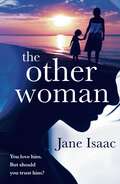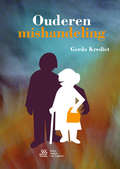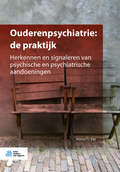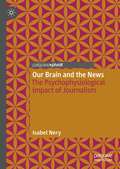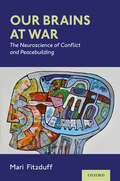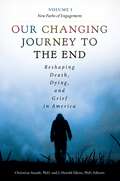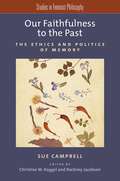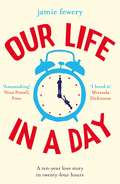- Table View
- List View
The Other Woman: A suspenseful crime thriller with a domestic noir twist (DC Beth Chamberlain #1)
by Jane IsaacThe grieving widow. The other woman. Which one is which? When Cameron Swift is shot and killed outside his family home, DC Beth Chamberlain is appointed Family Liaison Officer. Her role is to support the family – and investigate them. Monika, Cameron's partner and mother of two sons, had to be prised off his lifeless body after she discovered him. She has no idea why anyone would target Cameron. Beth can understand Monika's confusion. To everyone in their affluent community, Monika and her family seemed just like any other. But then Beth gets a call. Sara is on holiday with her daughters when she sees the news. She calls the police in the UK, outraged that no one has contacted her to let her know or offer support. After all, she and Cameron had been together for the last seven years. Until Cameron died, Monika and Sara had no idea each other existed. As the case unfolds, Beth discovers that nothing is quite as it appears and everyone, it seems, has secrets. Especially the dead... Previously published as After He's Gone, The Other Woman is the first book featuring DC Beth Chamberlain. Praise for Jane Isaac: 'Gripping subjects, brilliantly drawn characters and a twisty turny journey from beginning to end. A tense, thrilling read and definitely 5 humongous ????? from me' Angela Marsons on Hush Little Baby. 'Jane Isaac knows how to tell a good yarn. Expertly plotted and true to life' Mel Sherratt on For Better, For Worse. 'Isaac does a superb job of escalating the tension and dread' Publishers Weekly. 'Move over La Plante...' Susan May, Suspense Magazine. 'Tense, dark and gritty: perfect combination' Ian Patrick, author of Rubicon. 'Crime writing at its best' David Evans, CWA Debut Dagger-shortlisted author of Torment. 'Jane Isaac just gets better with every book. Deeply unsettling and unputdownable' Rebecca Bradley, bestselling author of the DI Hannah Robbins series. 'Jane Isaac writes unmissable quality crime fiction' Michael Wood, author of For Reasons Unknown. 'Gripped from the very first page... and just when you think it's over, it's really only the beginning' June Taylor, author of Losing Juliet. 'Brilliantly and intricately plotted, Jane Isaac has produced a terrific page-turner' Lizzie Sirett, Mystery People.
Otto Kernberg: A contemporary Introduction (Routledge Introductions to Contemporary Psychoanalysis)
by Diana Diamond Eve Caligor Frank E. YeomansIn this book, Frank E. Yeomans, Diana Diamond, and Eve Caligor provide a systemic review of Otto Kernberg’s multiple contributions to psychoanalysis, psychiatry, psychology, and our understanding of the mind and group behavior.The book spans the full scope of Kernberg’s career, both highlighting the diversity of topics on which his writings have shed light and emphasizing conceptual threads that link the different areas of his work. It accessibly follows the experiences that had an impact on the development of his thought and the increasingly strong impact his writing and thinking have had on psychoanalysis and related fields. The authors draw on their decades of working closely with Kernberg to offer a unique insight into his teaching and research, focusing on his work on borderline and narcissistic pathology and the fundamental conceptualization of personality disorders.Including an overview of Kernberg’s critique and expansion of traditional psychoanalytic training, as well as his role in developing transference-focused psychotherapy, this book is an invaluable guide to students, researchers, and analysts in practice and training looking to integrate Kernberg’s ideas into their own clinical and theoretical work.
Otto Kernberg: A contemporary Introduction (Routledge Introductions to Contemporary Psychoanalysis)
by Diana Diamond Eve Caligor Frank E. YeomansIn this book, Frank E. Yeomans, Diana Diamond, and Eve Caligor provide a systemic review of Otto Kernberg’s multiple contributions to psychoanalysis, psychiatry, psychology, and our understanding of the mind and group behavior.The book spans the full scope of Kernberg’s career, both highlighting the diversity of topics on which his writings have shed light and emphasizing conceptual threads that link the different areas of his work. It accessibly follows the experiences that had an impact on the development of his thought and the increasingly strong impact his writing and thinking have had on psychoanalysis and related fields. The authors draw on their decades of working closely with Kernberg to offer a unique insight into his teaching and research, focusing on his work on borderline and narcissistic pathology and the fundamental conceptualization of personality disorders.Including an overview of Kernberg’s critique and expansion of traditional psychoanalytic training, as well as his role in developing transference-focused psychotherapy, this book is an invaluable guide to students, researchers, and analysts in practice and training looking to integrate Kernberg’s ideas into their own clinical and theoretical work.
Ouderen in de geestelijke gezondheidszorg
by A. M. Pot Sako VisserOuderen vinden bij psychische problemen nog onvoldoende hun weg naar de geestelijke gezondheidszorg. Enerzijds omdat zij zelf niet om dergelijke hulp vragen, anderzijds omdat hulpverleners lang niet allemaal voldoende oog hebben. Dit boek biedt informatie over de laatste ontwikkelingen op dit gebied.
Ouderenmishandeling
by G. KredietHet boek ‘Ouderenmishandeling’ is bedoeld voor professionals in de zorg die in hun werk te maken krijgen met ouderen die mishandeld worden. Ouderenmishandeling is vaak een gevolg van overbelaste mantelzorg, echtelijke ruzies en opzettelijke mishandeling. De mishandeling kan bestaan uit lichamelijke mishandeling, psychische mishandeling, verwaarlozing, financiële uitbuiting en seksuele mishandeling. Het boek bestaat uit twee delen. In het eerste deel zijn vijftien casussen beschreven, waarna een analyse volgt van de gepleegde interventies en de resultaten. De casuïstiek is toegankelijk beschreven en maakt goed duidelijk wat ouderenmishandeling precies is, ook voor de nonprofessional. In het tweede deel worden interventiemogelijkheden beschreven die professionele hulpverleners concreet kunnen helpen bij de aanpak van ouderenmishandeling. Daarnaast vindt de lezer belangrijke informatie over wet- en regelgeving. ‘Ouderenmishandeling’ is een onmisbaar boek voor iedereen die zich beroepsmatig bezighoudt met ouderen: aandachtfunctionarissen, medewerkers Steunpunten Huiselijk Geweld, artsen, psychiaters, verpleegkundigen, thuiszorgmedewerkers, ouderenadviseurs en maatschappelijk werkers. Gerda Krediet werkte tien jaar als sociaalpsychiatrisch verpleegkundige bij het Meldpunt Ouderenmishandeling van de GGD Rotterdam-Rijnmond. Zij is nu directeur van Nood Zaak, een bureau voor advies, onderzoek en interventie bij ouderenmishandeling, en professioneel mentorschap.
Ouderenpsychiatrie: Herkennen en signaleren van psychische en psychiatrische aandoeningen
by Martin G. KatDit boek leert zorgprofessionals die werken met ouderen, om psychiatrische en psychische aandoeningen bij hun cliënten te herkennen en signaleren. Zij kunnen dankzij dit boek vroege adequate behandeling mogelijk maken.Dit boek koppelt praktijkvoorbeelden aan de beschreven aandoeningen bij ouderen. Professionals die werken met ouderen, zoals verzorgenden, (wijk)verpleegkundigen, POH’s en casemanagers.
Our Autistic Lives: Personal Accounts from Autistic Adults Around the World Aged 20 to 70+
by Edited by Alex RatcliffeThis collection of narratives from autistic adults is structured around their decades of experience of life, covering 20s, 30s, 40s, 50s, 60 and 70s+. These are varied and diverse, spanning different continents, genders, sexualities and ethnicities, yet the author highlights the common themes that unite them and skilfully draws out these threads. Each chapter is based on accounts from one age group and includes accounts from people of that age, giving an insight into the history of autism and signifying how gaining a diagnosis (or not) has changed people's lives over time. The book is about ageing with an autistic mind, and helping the reader find connections between neurotypical and neurodiverse people by acknowledging the challenges we all face in our past, present and futures.
Our Brain and the News: The Psychophysiological Impact of Journalism
by Isabel NeryThis book explores the impact of news and literary journalism on human cognition and emotion. Providing an innovative analysis of psycho-physiological measures, including emotional response, perception of pain, and changes in heartbeat, Nery seeks to understand how readers react to journalistic texts. There is a growing enthusiasm in the search for understanding the processing of information, with some already arguing for the establishment of the neuroscience of communication as a new discipline. By combing neuroscience methods with communication research studies, specifically journalistic research and theory, Nery offers us a unique way of exploring and thinking about news, literary journalism, and the brain.
Our Brains Are Like Computers!: Exploring Social Skills and Social Cause and Effect with Children on the Autism Spectrum (PDF)
by Joel ShaulThis highly visual social skills book uses computer metaphors and visual diagrams to help children on the autism spectrum to understand how their words and actions can affect other people. Easily identifiable computing and social networking metaphors are used to explain how memories are saved in the brain, like files in computer folders, and how, just as files can be shared and downloaded on the internet, people learn about you by sharing their positive and negative impressions with each other. The author explains why certain actions may be 'liked' or 'disliked' by others, and offers guidance on appropriate and inappropriate social behavior. This book also features photocopiable worksheets to reinforce the guidance and lessons offered in the book.
Our Brains at War: The Neuroscience of Conflict and Peacebuilding
by Mari FitzduffOur Brains at War: The Neuroscience of Conflict and Peacebuilding suggests that we need a radical change in how we think about war, leadership, and politics. Most of us, political scientists included, fail to appreciate the extent to which instincts and emotions, rather than logic, factor into our societal politics and international wars. Many of our physiological and genetic tendencies, of which we are mostly unaware, can all too easily fuel our antipathy towards other groups, make us choose 'strong' leaders over more mindful leaders, assist recruitment for illegal militias, and facilitate even the most gentle of us to inflict violence on others. Drawing upon the latest research from emerging areas such as behavioral genetics, biopsychology, and social and cognitive neuroscience, this book identifies the sources of compelling instincts and emotions, and how we can acknowledge and better manage them so as to develop international and societal peace more effectively.
Our Brains at War: The Neuroscience of Conflict and Peacebuilding
by Mari FitzduffOur Brains at War: The Neuroscience of Conflict and Peacebuilding suggests that we need a radical change in how we think about war, leadership, and politics. Most of us, political scientists included, fail to appreciate the extent to which instincts and emotions, rather than logic, factor into our societal politics and international wars. Many of our physiological and genetic tendencies, of which we are mostly unaware, can all too easily fuel our antipathy towards other groups, make us choose 'strong' leaders over more mindful leaders, assist recruitment for illegal militias, and facilitate even the most gentle of us to inflict violence on others. Drawing upon the latest research from emerging areas such as behavioral genetics, biopsychology, and social and cognitive neuroscience, this book identifies the sources of compelling instincts and emotions, and how we can acknowledge and better manage them so as to develop international and societal peace more effectively.
Our Changing Journey to the End [2 volumes]: Reshaping Death, Dying, and Grief in America [2 volumes]
by Christina StaudtThis novel, cross-disciplinary collection explains how dying, death, and grieving have changed in America, for better or worse, since the turn of the millennium.What does dying with dignity mean in a diverse society with rapidly advancing technology, an aging population, and finite resources? In this fascinating collection, scholars from across the nation illuminate the remarkable changes that have taken place in recent years, are now underway, and loom on the horizon as they lead readers on an exploration of the ways Americans think about and handle dying and death. Volume 1, New Paths of Engagement, addresses changes in the circumstances and expressions of death, dying, and grief in 21st-century America. Volume 2, New Venues in the Search for Dignity and Grace, delves into the challenges inherent in creating a medical and social system that allows for an optimal end-of-life experience for all and proposes ways in which society can be reshaped to move toward that ideal.
Our Changing Journey to the End [2 volumes]: Reshaping Death, Dying, and Grief in America [2 volumes]
by Christina Staudt J. Harold EllensThis novel, cross-disciplinary collection explains how dying, death, and grieving have changed in America, for better or worse, since the turn of the millennium.What does dying with dignity mean in a diverse society with rapidly advancing technology, an aging population, and finite resources? In this fascinating collection, scholars from across the nation illuminate the remarkable changes that have taken place in recent years, are now underway, and loom on the horizon as they lead readers on an exploration of the ways Americans think about and handle dying and death. Volume 1, New Paths of Engagement, addresses changes in the circumstances and expressions of death, dying, and grief in 21st-century America. Volume 2, New Venues in the Search for Dignity and Grace, delves into the challenges inherent in creating a medical and social system that allows for an optimal end-of-life experience for all and proposes ways in which society can be reshaped to move toward that ideal.
Our Cheating Hearts: Love and Loyalty, Lust and Lies
by Kate FigesBy the author known and respected for her acclaimed books on relationships.Most of us manage to be monogamous, most of the time, but who cannot imagine themselves committing the 'crime' of adultery? Does being 'faithful' mean the same to everyone? Why DO people have affairs?Using real life testimony alongside the most current research, Our Cheating Hearts looks at the big questions around love and commitment. It lifts taboos, asks the tough questions and shows how in our progressive time monogamy has become the new ideal.Some people manage monogamy. For the countless others that don't, Our Cheating Hearts opens the debate and provides the honest approach that's essential.
Our Dark Side: A History of Perversion
by Elisabeth RoudinescoWhere does perversion begin? Who is perverse? Ever since the word first appeared in the Middle Ages, anyone who delights in evil and in the destruction of the self or others has been described as 'perverse'. But while the experience of perversion is universal, every era has seen it and dealt with it in its own way. The history of perversion in the West is told here through a study of great emblematic figures of the perverse - Gilles de Rais, the mystical saints and the flagellants in the middle ages, the Marquis de Sade in the eighteenth century, the masturbating child, the male homosexual and the hysterical woman nineteenth century, Nazism in the twentieth century, and the complementary figures of the paedophile and the terrorist in the twenty-first. The perverse are rarely talked about and when they are it is usually only to be condemned. They are commonly viewed as monstrous and cruel, as something alien to the very nature of being human. And yet, perversion can also attest to creativity and self-transcendence, to the refusal of individuals to submit to the rules and prohibitions that govern human life. Perversion fascinates us precisely because it can be both abject and sublime. Whether they are sublime because they turn to art or mysticism, or abject because they surrender to their murderous impulses, the perverse are part of us because they exhibit something that we always conceal: our own negativity and our dark side.
Our Dark Side: A History of Perversion
by Elisabeth RoudinescoWhere does perversion begin? Who is perverse? Ever since the word first appeared in the Middle Ages, anyone who delights in evil and in the destruction of the self or others has been described as 'perverse'. But while the experience of perversion is universal, every era has seen it and dealt with it in its own way. The history of perversion in the West is told here through a study of great emblematic figures of the perverse - Gilles de Rais, the mystical saints and the flagellants in the middle ages, the Marquis de Sade in the eighteenth century, the masturbating child, the male homosexual and the hysterical woman nineteenth century, Nazism in the twentieth century, and the complementary figures of the paedophile and the terrorist in the twenty-first. The perverse are rarely talked about and when they are it is usually only to be condemned. They are commonly viewed as monstrous and cruel, as something alien to the very nature of being human. And yet, perversion can also attest to creativity and self-transcendence, to the refusal of individuals to submit to the rules and prohibitions that govern human life. Perversion fascinates us precisely because it can be both abject and sublime. Whether they are sublime because they turn to art or mysticism, or abject because they surrender to their murderous impulses, the perverse are part of us because they exhibit something that we always conceal: our own negativity and our dark side.
Our Desire of Unrest: Thinking About Therapy
by Michael JacobsKnowledge is never static. It is always open to revolutionary thinking or to evolving development. Similarly an individual's knowledge is always moving, and indeed if the ability to think about ideas is lost, an important part of the individual is also lost. In this book, a collection of some of the papers and lectures written by Michael Jacobs over a period of thirty or more years, the author shows his own thinking at work, as he challenges himself to look deeper at some important aspects of his discipline - principally psychodynamic psychotherapy, although always with reference to other forms of discourse such as literature and theology. Here the reader will find the writer behind those popular texts such as The Presenting Past, Psychodynamic Counselling in Action, and Shakespeare on the Couch.
Our Desire of Unrest: Thinking About Therapy (The\united Kingdom Council For Psychotherapy Ser.)
by Michael JacobsKnowledge is never static. It is always open to revolutionary thinking or to evolving development. Similarly an individual's knowledge is always moving, and indeed if the ability to think about ideas is lost, an important part of the individual is also lost. In this book, a collection of some of the papers and lectures written by Michael Jacobs over a period of thirty or more years, the author shows his own thinking at work, as he challenges himself to look deeper at some important aspects of his discipline - principally psychodynamic psychotherapy, although always with reference to other forms of discourse such as literature and theology. Here the reader will find the writer behind those popular texts such as The Presenting Past, Psychodynamic Counselling in Action, and Shakespeare on the Couch.
Our Encounters With Self-Harm (PDF)
by Charley Baker Clare Shaw Fran BileyThe 'Our Encounters with - ' series collect together unnmediated, unsanitised narratives by service-users, past service-users and carers. These stories of direct experience will be of great benefit to those interested in narrative enquiry, and to those studying and practising in the field of mental health. This collection brings together a range of voices on the theme of self-harm - from those who have experienced self-harm directly, alongside the friends, family and staff who live and work with self-harm. Too often, our understanding of the unique and complex experiences of people who self-harm is limited to concepts of mental illness, disorder and disease. Yet these stories demonstrate the strength, survival and recovery of people with rich and diverse lives. Inspiring, hopeful and at times challenging to read, the contributors who have so generously shared their experiences in this book will promote understanding and compassion, improve attitudes and care, and offer hope to those who are personally encountering self-harm. In this respect, this book is of immense value to all those working with self-harm across a spectrum of services and roles, and to those living with self-harm.
Our Faithfulness To The Past Sfp C: The Ethics And Politics Of Memory
by Sue Campbell Christine M. Koggel Rockney JacobsenOur Hopes, Our Future: Insights from the Hope Barometer
by Andreas M. KrafftHow can we overcome crises and shape our common future?Since the beginning of the Corona pandemic, we have all been put to an immense test. This shows how humanity can successfully and constructively deal with such situations and make the best of them. And we learn that the future is not something that happens to us, but that we can actively and constructively shape it. The basic prerequisite for this is an attitude of openness, mutual helpfulness and hope. This non-fiction book vividly reports on the currently prevailing images of the future and the common longings as well as on people's capacity for hope and action. It reveals the power of desirable images of the future and of a collective hope as the opposite of general helplessness or of blind and naïve optimism. The central statements of this book are based on the experiences of thousands of people in more than ten countries who participated in the scientific study of the Hope Barometer in 2019 and 2020. In a unique way, this combines lived practice with the latest findings of social science futurology, positive psychology and pragmatic philosophy. Target groups:This book is for anyone who wants to look to the future with hope. It offers concrete answers to key questions and shows how crises can be overcome while shaping a better future for individuals and society as a whole. About the author:Dr. Andreas M. Krafft teaches at the University of St. Gallen and at the Free University of Berlin. As co-president of swissfuture, the Swiss Association for Futures Research, and as a board member of the Swiss Society for Positive Psychology, he leads the international research network of the Hope Barometer.
Our House: Making Sense of Dissociative Identity Disorder (Understanding Dissociative Identity Disorder)
by Lindsay SchofieldOur House tells the story of a child who has experienced something that children should never have to experience. It introduces the reader to the people who arrived to help them cope with the bad things, in the house that they all share. Accompanied by beautiful and gentle illustrations, the story takes a non-threatening approach to demystify dissociative identity disorder, using the metaphor of a house to explain what it is and how it develops. Our House can be read by individuals, or used as a treatment tool to stimulate discussion, and is suitable for all ages. It includes additional guidance which explains the metaphor in depth, as well as advice regarding dissociative disorders and signposts to further help for both individuals and professionals. Bringing clarity to a complex issue, this is an invaluable resource for survivors of trauma and for those who support them, counsellors, psychologists, social care workers and other professionals, as well as family and friends. An accompanying guidebook is also available, offering further information, resources and activities, and page-by-page insights into illustrations from the picture book. Both books can be purchased as a set.
Our Inner World: A Guide to Psychodynamics and Psychotherapy
by Scott R. AhlesMental health practitioners and students learning psychodynamic psychotherapy are often exposed to multiple schools of thought—Freudian theory, interpersonal theory, ego theory, object-relations theory, self-psychology, and affect theory. In this book, Scott Ahles introduces and explains the major theories and integrates them into a model of psychodynamics that can be used to treat common psychiatric complaints. After explaining the theories, Ahles, applies an integrated approach to two general areas of patient discomfort: problems with sense of self, such as anxiety, depression, low self-esteem, and feelings of worthlessness; and problems with interpersonal relationships, such as difficulty forming long-term relationships, excessive shyness or fear of others, and aggressive personality. The psychotherapy of both problems of sense of self and interpersonal relationships are discussed and illustrated with clinical cases. Ahles also discusses the psychodynamic model in relation to neurobiological research into brain function, and he explores how psychotherapy can best be combined with pharmacotherapy. Throughout, the primary concepts of object relations and ego psychology are demonstrated with diagrams and case studies. A valuable tool for teaching concepts to students of psychiatry, psychology, social work, and general medicine, Our Inner World allows the future clinician to keep various psychodynamic aspects of the patient in mind during treatment.
Our Journey Through High Functioning Autism and Asperger Syndrome: A Roadmap
by Linda Andron Tony Attwood Liane Holliday WilleyFor the families who have contributed to this book, living with autism spectrum disorders has been a journey of self-discovery. With honesty and humor, they describe the ways autism has affected their daily lives, the challenges they have faced and the approaches they have found beneficial. They share their practical and original strategies for dealing with issues such as helping children to develop empathy and humor, developing and maintaining friendships and explaining their autism spectrum disorders to other people. This book will be a source of advice and inspiration for families of children with autism and the professionals who work with them. It is practical, realistic and positive - autism is seen as something to be understood and celebrated. As 11-year-old Glen states in the Appendix, written by some of the children with autism featured in the book: `I like myself and consider my difference something positive.'
Our Life in a Day: The most uplifting and heartbreaking love story of 2019
by Jamie Fewery'A beautifully told story of real love and real life. I loved it' Miranda Dickinson'Clever, moving, funny, insightful' Zoë Folbigg, author of THE NOTEIf you are looking for the perfect love story for summer 2019, then escape with the book readers are calling 'happy, sad, emotional & uplifting', 'heartbreaking' and 'real and honest.'________________________________The rules are simple: choose the most significant moments from your relationship - one for each hour in the day.You'd probably pick when you first met, right? And the instant you knew for sure it was love? Maybe even the time you watched the sunrise after your first night together?But what about the car journey on the holiday where everything started to go wrong? Or your first proper fight?Or that time you lied about where you'd been?It's a once in a lifetime chance to learn the truth.But if you had to be completely honest with the one you love, would you still play?For Esme and Tom, the game is about to begin. But once they start, there's no going back . . .Following Esme and Tom's relationship over twenty-four individual hours of ups, downs and everything in between, Our Life in a Day is the most heartbreaking and moving love story you'll read in 2019 - perfect for fans of Josie Silver's One Day in December, Jojo Moyes, and Roxie Cooper's The Day We Met.'I raced through it' DAILY MAIL________________________________WHAT REAL READERS ARE SAYING:'Oh my heart. I absolutely loved this book' Jo'Heartbreaking but brilliant' A. Douglas'I was captivated by this novel' Lindsay'An original, witty and tear-jerking book' Nicole'Happy, sad, emotional & uplifting' A Sawyer'Real and honest' B Dragon
